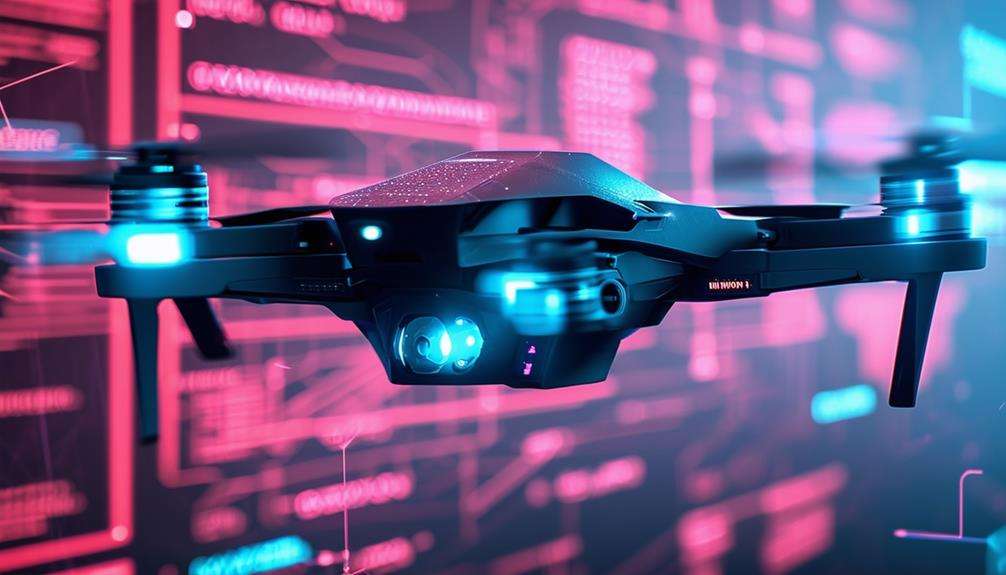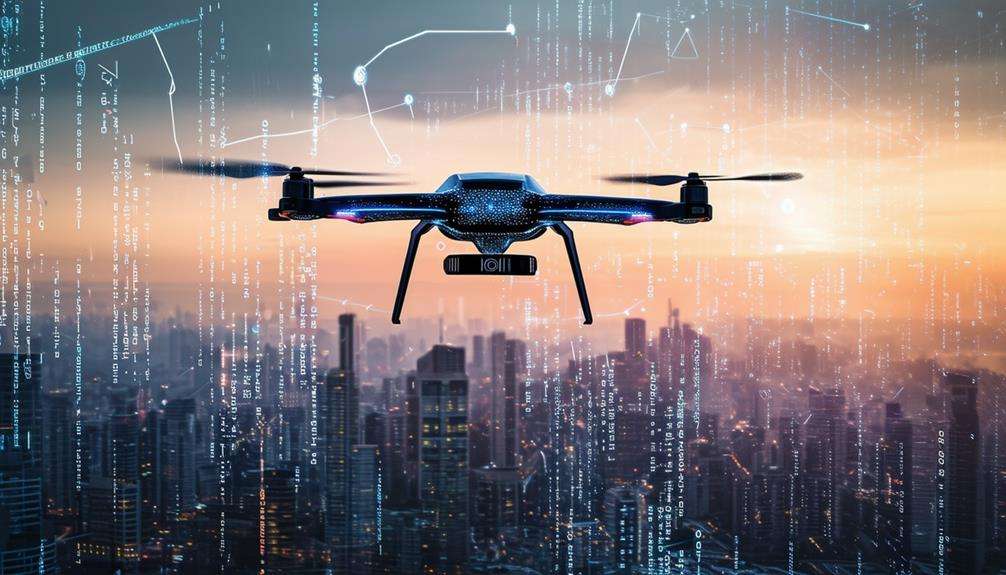The Future of Drone Technology: What History Tells Us
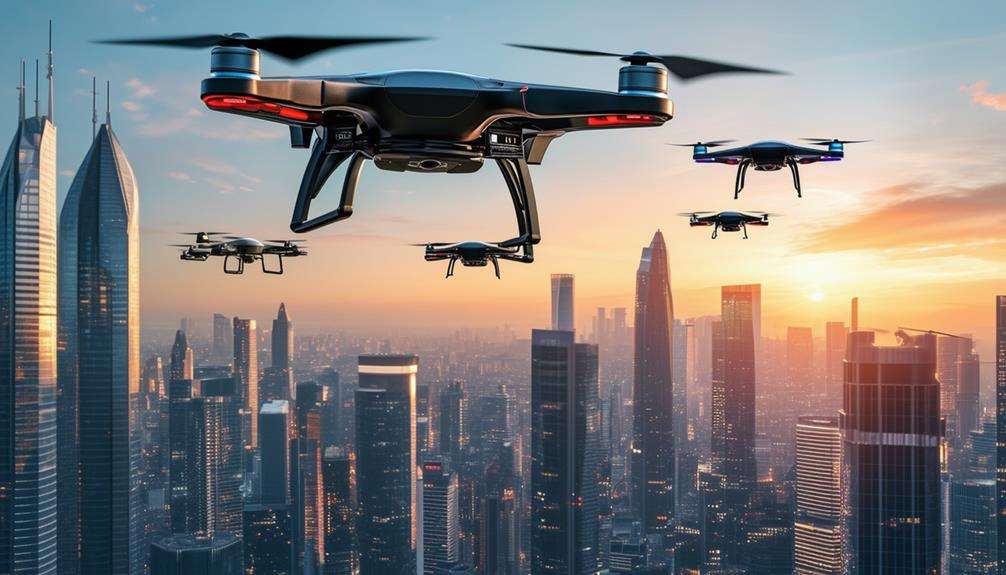
The evolution of drone technology has followed a clear trajectory of rapid advancement. From rudimentary 19th-century innovations to sophisticated military applications in both World Wars, drones have come a long way. The Canberra U Mk 10 jet drone in 1961 marked a significant leap, paving the way for today's high-tech, versatile drones.
This historical progression suggests a future where emerging trends such as extended flight times, 5G connectivity, and AI capabilities will further transform the technology. These advancements will undoubtedly have far-reaching implications for various sectors, including logistics, surveillance, and emergency response.
Early Drone Innovations
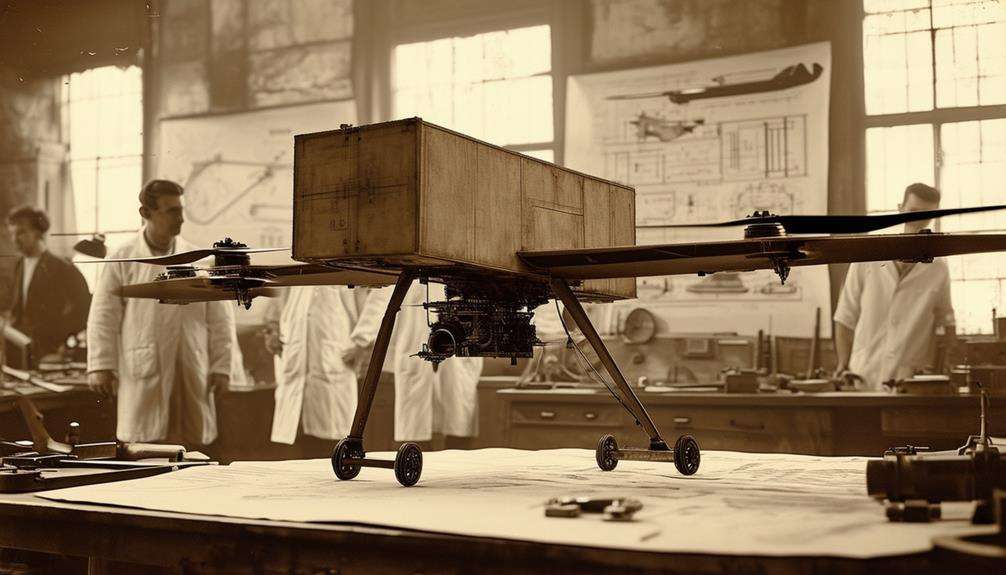
Early drone innovations can be traced back to the mid-19th century, with devices like the Aerial Target and Queen Bee being used for training and target practice during World War I. These initial experiments laid the groundwork for modern drone technology. Although primitive by today's standards, these pioneering prototypes represented significant steps forward in drone history.
In 1946, a drone based on a B-17 Flying Fortress airframe set an endurance record, marking a key milestone. This achievement demonstrated the potential for drones to operate over extended periods, paving the way for future advancements.
By 1961, the Canberra U Mk 10 jet plane was being used as a pilotless drone for target location during the Seaslug guided missile trials, showcasing the evolution of drone technology into more sophisticated and versatile systems. The Midge Surveillance Drone, used by the British Army, featured rocket-powered flight and pre-programmed paths, highlighting the growing role of drones in aerial reconnaissance.
Military Applications
As drone technology has advanced, its military applications have expanded from basic surveillance to include precision strikes and intelligence gathering. Military drones, or unmanned aerial vehicles (UAVs), now play a pivotal role in modern warfare. Their use in targeted operations began with the CIA's initial drone strike in 2002. Today, the United States operates over 8,000 drones for various military purposes.
The shift from manned to unmanned systems offers several advantages. Autonomous flight capabilities reduce risks to human pilots, enabling missions that would otherwise be too dangerous. However, the growing reliance on drones raises ethical questions, particularly concerning civilian casualties and the psychological impact on remote operators.
Here are some key aspects of military drone use:
| Aspect | Description | Example |
|---|---|---|
| Number of Drones | Over 8,000 in U.S. military service | Models like Predator and Reaper |
| Initial Strike | First targeted drone strike by the CIA in 2002 | Precision strike on high-value targets |
| Advantages | Reduced pilot risk, autonomous flight | Conducting dangerous missions remotely |
| Ethical Concerns | Civilian casualties, psychological impact | Increased scrutiny in warfare ethics |
| Design Innovations | Inspired by video game technology | Advanced future drone capabilities |
Military drones are reshaping the battlefield, but this evolution necessitates careful consideration of their implications.
Technological Advancements
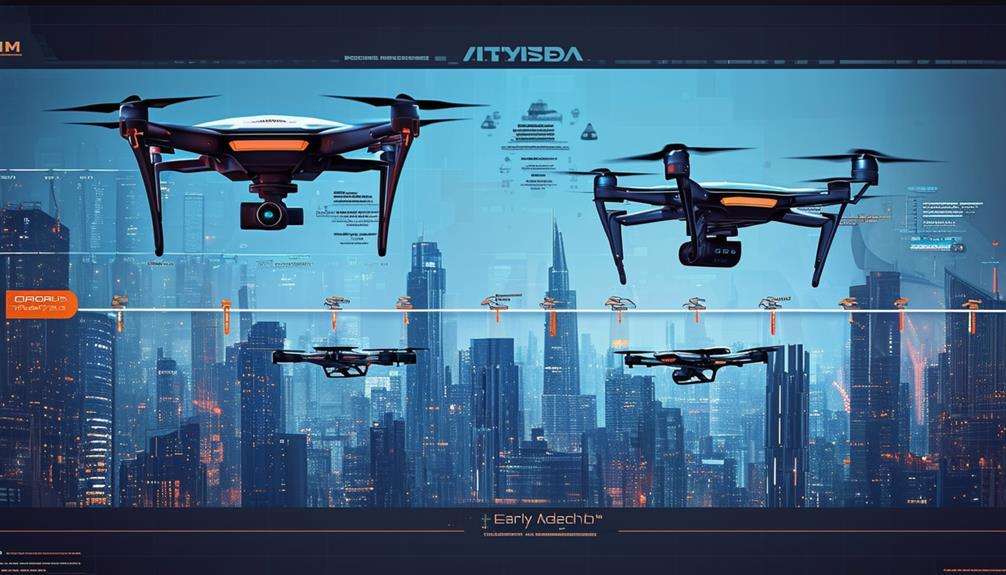
When considering the future of drone technology, advancements in miniaturization and efficiency are key. Enhanced AI capabilities are revolutionizing drone navigation and interaction with their environments. Additionally, innovations in battery life are extending the operational limits of these devices.
Miniaturization and Efficiency Gains
Advancements in drone technology have led to significant miniaturization and efficiency gains, transforming various industries. Drones are now smaller and more compact, enhancing their portability and stealth capabilities. This miniaturization enables drones to perform intricate tasks such as inspection, surveillance, and reconnaissance with exceptional precision, thanks to sophisticated sensors and cameras.
Efficiency improvements, particularly in battery life, have significantly extended drone flight times. With advanced battery designs and energy management systems, drones can now undertake longer missions and cover broader operational ranges. Improved aerodynamics and propulsion systems further enhance these efficiencies, allowing for faster speeds and better maneuverability.
Consequently, modern drone technology provides agile, versatile, and cost-effective solutions across multiple applications. Whether in agriculture, construction, or emergency response, these advancements mean drones can handle tasks requiring both precision and endurance.
Enhanced AI Capabilities
Recent advancements in miniaturization and efficiency have empowered drone technology to leverage enhanced AI capabilities for autonomous flight and decision-making. With AI integration, drones can perform real-time data analysis, significantly boosting their efficiency in various applications. This technological leap allows drones to undertake complex tasks with minimal human intervention.
Here are four key benefits of AI integration in drones:
- Autonomous Flight: AI enables drones to operate independently, making real-time decisions without constant human oversight.
- Real-Time Data Analysis: Drones can analyze data as they collect it, offering immediate insights and facilitating rapid adjustments.
- Obstacle Avoidance: Advanced algorithms allow drones to detect and navigate around obstacles, ensuring safer and more reliable operations.
- Adaptability: AI-powered drones can adjust to changing environments, optimizing their performance and mission success.
These capabilities make drones smarter, more versatile, and increasingly autonomous. Integrating AI allows drones to execute complex missions, efficiently plan routes, and seamlessly avoid obstacles. This revolution in drone technology enhances their operational effectiveness and broadens their application across diverse industries, including agriculture and emergency response.
Battery Life Innovations
In recent years, advancements in battery technology have significantly enhanced the operational capabilities of drones. The introduction of lithium polymer batteries has led to remarkable improvements in drone endurance, transforming a previous limitation into a strength. Modern drones now achieve flight times ranging from 30 minutes to several hours. For example, DJI's Mavic 2 Pro drone showcases this progress with a notable 31-minute flight time.
This leap in battery life enables drones to cover more ground, conduct prolonged surveillance missions, and support a wide range of applications. Whether for long-distance deliveries, search and rescue missions, or agricultural monitoring, the operational capabilities of drones have expanded considerably.
Here's a quick comparison of different drones and their battery life:
| Drone Model | Battery Life | Key Applications |
|---|---|---|
| DJI Mavic 2 Pro | 31 minutes | Photography, Surveillance |
| Parrot Anafi | 25 minutes | Filmmaking, Inspections |
| Autel Evo II | 40 minutes | Mapping, Search & Rescue |
| DJI Phantom 4 Pro | 30 minutes | Surveying, Agriculture |
| Skydio 2 | 23 minutes | Autonomous Flight, Sports |
These innovations in battery technology are crucial for the future of drone technology, enabling them to perform longer, more diverse missions with increased efficiency.
Drones in Law Enforcement
Law enforcement agencies across the U.S. have progressively adopted drones, transforming how they gather evidence and monitor incidents in real-time. This shift isn't just a technological upgrade; it's a significant milestone in law enforcement. By leveraging advanced drone technology, agencies can now perform tasks that were once difficult or impossible. Over 5,000 public safety agencies use drones, illustrating their growing importance.
Here are four key benefits that drones bring to law enforcement:
- Real-time visibility: Drones provide immediate aerial views of crime scenes, accidents, and public events, enabling officers to make informed decisions quickly.
- Evidence gathering: Drones can capture high-resolution images and videos, preserving essential evidence for court use.
- Incident investigations: Drones allow officers to thoroughly examine hard-to-reach areas, ensuring no detail is overlooked.
- Fleet management: Solutions from companies like Axon Air facilitate the management and effective deployment of drone fleets.
However, challenges remain, such as managing crowded airspace and preventing drone interference. Yet, the adoption of this technology continues to evolve, promising even greater advancements in the future.
Civilian Uses
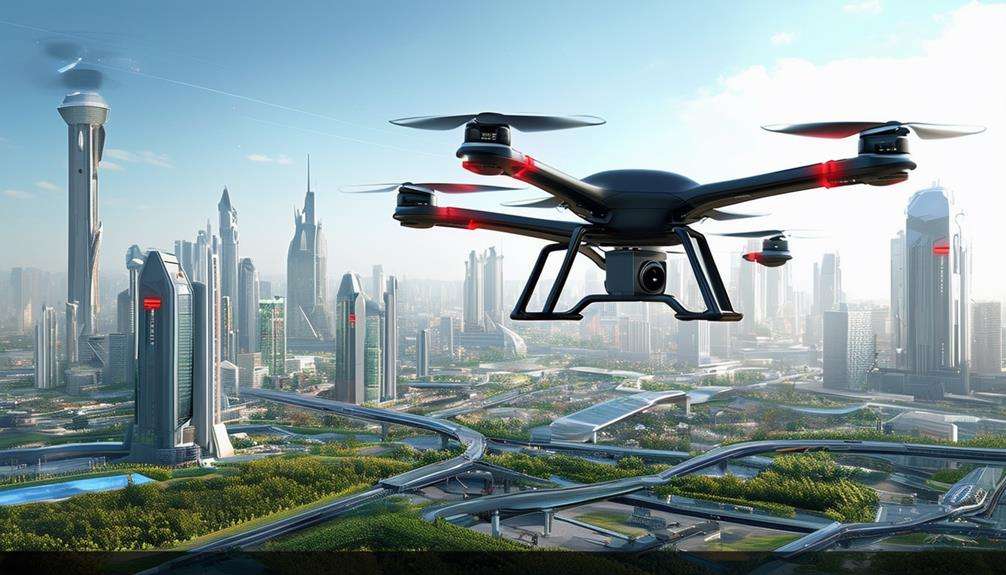
As drone technology continues to advance, civilians are finding innovative ways to integrate these versatile devices into daily life. From search and rescue missions to drone photography and delivery services, drones are transforming various aspects of civilian activities. For instance, drones equipped with cameras can capture breathtaking aerial shots, revolutionizing photography and filmmaking.
In search and rescue operations, drones can swiftly cover large areas, locating missing persons more efficiently than traditional methods. Additionally, companies like Amazon and UPS are pioneering drone delivery services, aiming to deliver packages and goods directly to consumers' doorsteps.
Drones are also invaluable in environmental monitoring, providing crucial data for conservation projects. The civilian drone market is thriving, with projections estimating a global market value of over $40 billion by 2025. These innovations underscore the transformative potential of drones in everyday civilian applications.
Regulatory Challenges
Regulating the rapidly growing drone industry presents a range of challenges that authorities must address proactively. By early 2023, over 871,000 drones and 307,000 certified Remote Pilots were registered, highlighting the need for stringent oversight. Since 2016, the FAA has led efforts to establish rules on no-fly zones and pilot certification. However, the increasing prevalence of drones introduces several regulatory challenges that are crucial to understand.
- Emergency Response Disruptions: Drones can interfere with firefighters and other emergency responders, complicating critical operations.
- Law Enforcement Integration: The use of drones in police work requires careful management to avoid disrupting ongoing investigations or emergency scenarios.
- State Legislation: States are enacting laws to address the risks of unauthorized drone activity, particularly in sensitive areas.
- Technological Advancements: Innovations such as improved battery life and AI integration enhance drone capabilities, necessitating updated regulations to keep pace with these advancements.
Addressing these challenges is essential to ensuring that the benefits of drone technology are maximized while minimizing risks to public safety and security. Effective regulation will enable the industry to grow responsibly and innovatively.
Ethical Considerations
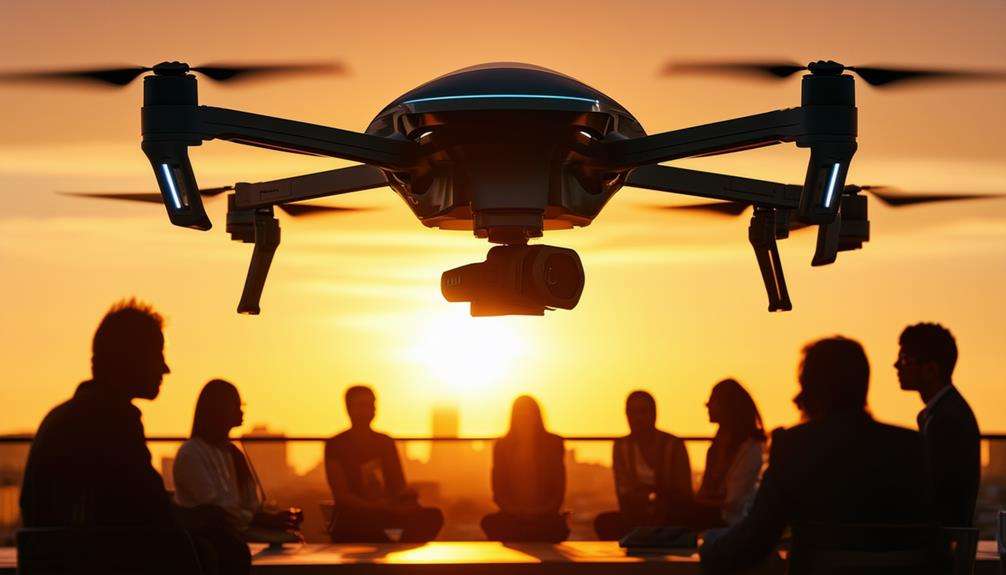
When considering the ethics of drone technology, it's essential to address privacy and surveillance issues that impact daily life. Additionally, the advent of autonomous drones raises concerns about decision-making processes that occur without human oversight. Addressing these issues is crucial to ensure the responsible development and use of drone technology.
Privacy and Surveillance Issues
Given their ability to conduct surveillance without consent, drones present significant privacy concerns that demand urgent ethical scrutiny. Equipped with high-resolution cameras, these devices can capture detailed images of private property and personal activities, raising serious questions about data protection and privacy rights.
The rapid pace of drone technology development often outstrips the ability of legal frameworks to keep up, leading to numerous ethical dilemmas.
Here are four key privacy concerns associated with drone surveillance:
- Involuntary Surveillance: Drones can monitor individuals without their knowledge, creating a sense of constant surveillance.
- Data Security: Collected data could be hacked or misused, compromising personal privacy.
- Legal Gaps: Current laws may not adequately address the nuances of drone surveillance, leaving gaps in protection.
- Authoritative Misuse: Governments or law enforcement could use drones for intrusive surveillance, infringing on civil liberties.
Balancing the benefits of drone technology with protecting individuals' privacy rights is a critical challenge. Policymakers must work diligently to craft regulations that address these privacy concerns while allowing for the positive uses of drones.
Autonomous Decision Making
As autonomous drones continue to advance, their ability to make decisions without human oversight raises significant ethical concerns. Driven by sophisticated AI algorithms, these drones can independently select targets and execute missions. While this technology enhances efficiency and reduces human risk, it also introduces several troubling issues.
A primary ethical concern is the potential for errors in target identification. In the absence of human intervention, autonomous drones might mistakenly engage non-combatants, resulting in unintended casualties. This raises questions about adherence to international rules of engagement and the ethical implications of using such technology in warfare.
Moreover, the deployment of autonomous drones obscures the lines of responsibility and accountability. If a drone makes a fatal error, determining who's at fault becomes challenging. Is the blame on the programmer, the manufacturer, or the military commander who authorized its use? This ambiguity complicates legal and moral responsibility in military operations.
Ongoing discussions among policymakers and international organizations are addressing these ethical concerns.
As the future of drone technology unfolds, it's crucial to weigh their decision-making capabilities against the potential risks and ethical dilemmas they introduce. Balancing innovation with accountability remains a key challenge.
Future Trends
Advancements in AI will significantly enhance drones' autonomy and decision-making capabilities. In the future, artificial intelligence will enable drones to operate more independently, making real-time decisions based on their surroundings. This will allow drones to adapt dynamically to new situations, enhancing their versatility and efficiency.
Several key trends are expected to shape the future of drone technology:
- Extended Flight Times: Innovations in battery technology will enable drones to fly longer, increasing their operational efficiency and reducing the need for frequent recharges.
- Improved Connectivity: Integration with 5G and IoT will provide better connectivity and faster data transmission, facilitating more complex and data-intensive applications.
- Expanded Applications: Drones will find use in a broader range of scenarios, from disaster response and search-and-rescue missions to urban planning and agricultural monitoring.
- Regulatory Developments: Evolving regulations and standards will establish ethical and legal guidelines to ensure the responsible and safe use of drones.
Understanding these trends will help you stay ahead in the rapidly evolving landscape of drone technology. As AI, connectivity, and regulation continue to advance, the possibilities for drone applications will only expand.
Conclusion
The evolution of drone technology, from early innovations to present-day advancements, has been remarkable.
Drones have demonstrated their value across military, law enforcement, and civilian applications.
Looking ahead, trends such as extended flight times, 5G connectivity, and AI integration will further enhance their capabilities.
As regulations and ethical guidelines evolve, drones will play an increasingly significant role in shaping the future, making our interactions with technology and the world more dynamic and efficient.



